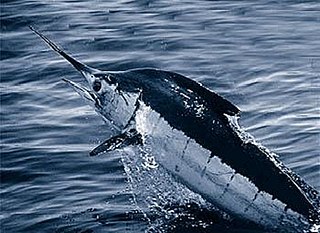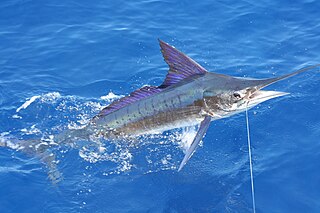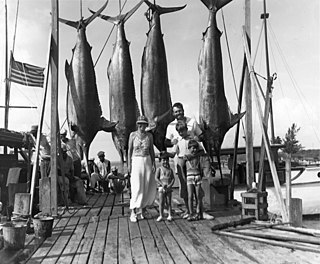
The Miami Marlins are an American professional baseball team based in Miami. The Marlins compete in Major League Baseball (MLB) as a member of the National League (NL) East Division. The club's home is LoanDepot Park.

Marlins are fish from the family Istiophoridae, which includes 11 species.

The 2003 World Series was the championship series of Major League Baseball's (MLB) 2003 season. The 99th edition of the World Series, it was a best-of-seven playoff between the National League (NL) champion Florida Marlins and the American League (AL) champion New York Yankees; the Marlins upset the heavily-favored Yankees, four games to two. The series was played from October 18 to 25, 2003. This is the most recent Series in which the losing team outscored the winning team; the Yankees lost, despite outscoring the Marlins 21–17 in the Series. This was the Marlins' second World Series championship win, having won their first in 1997. The Marlins would not return to the postseason until 2020.

The Exocoetidae are a family of marine ray-finned fish in the order Beloniformes, known colloquially as flying fish or flying cod. About 64 species are grouped in seven genera. While they cannot fly in the same way a bird does, flying fish can make powerful, self-propelled leaps out of the water where their long wing-like fins enable gliding for considerable distances above the water's surface. The main reason for this behavior is thought to be to escape from underwater predators, which include swordfish, mackerel, tuna, and marlin, among others, though their periods of flight expose them to attack by avian predators such as frigate birds.

Calliactis is a genus of sea anemones. Species in this genus are mutually symbiotic with hermit crabs. The anemone gets a place to live and discarded scraps of the crab's food in exchange for its help in defending the crab.

The white marlin, also known as Atlantic white marlin, marlin, skilligalee, is a species of billfish that lives in the epipelagic zone of the tropical and subtropical Atlantic Ocean. They are found between the latitudes of 45° N and 45° S in waters deeper than 100 m. Even though white marlin are found in bodies of water that are deeper than 100 m they tend to stay near the surface. White marlin have been found near banks, shoals, and canyons, but they are not limited to those locations. They prefer warm surface temperatures greater than 22 °C.

The Atlantic blue marlin is a species of marlin endemic to the Atlantic Ocean. It is closely related to, and usually considered conspecific with, the Indo-Pacific blue marlin, then simply called blue marlin. Some authorities consider both species distinct.

The billfish are a group of saltwater predatory fish characterised by prominent pointed bills (rostra), and by their large size; some are longer than 4 m (13 ft). Extant billfish include sailfish and marlin, which make up the family Istiophoridae; and swordfish, sole member of the family Xiphiidae. They are often apex predators which feed on a wide variety of smaller fish, crustaceans and cephalopods. These two families are sometimes classified as belonging to the order Istiophoriformes, a group which originated around 71 million years ago in the Late Cretaceous, with the two families diverging around 15 million years ago in the Late Miocene. However, they are also classified as being closely related to the mackerels and tuna within the suborder Scombroidei of the order Perciformes. However, the 5th edition of the Fishes of the World does recognise the Istiophoriformes as a valid order, albeit including the Sphyraenidae, the barracudas.

The black marlin is a species of marlin found in tropical and subtropical areas of the Indian and Pacific Oceans approximately between 40 degrees North and 45 degrees South, while in some instances venturing into more temperate waters. Reaching lengths of over 4.5 m (15 ft), It is one of the largest marlins and also one of the largest bony fish. Marlin are among the fastest fish, but speeds may be exaggerated in popular media, such as reports of 132 km/h (82 mph). A 2016 study estimated maximum swimming speeds from muscle contraction times, which in turn limit the tail-beat frequency; the study suggested a theoretical upper limit for the black marlin's burst speed of 36 kilometres per hour (22 mph). Black marlin are fished commercially and are also a highly prized game fish. Black marlins were known to drag ancient Maldivian fishing boats for very long distances until the marlins tired; it would take many hours for the fishermen to row or sail back home. Due to the common misidentification of large billfish such as the black marlin, as well as its highly migratory habits and the lack of research into the species, much about populations are unknown. The species was first known as Tetrapturus indicus and later was reclassified as Makaira indica before taking on its current scientific name. One of the earliest scientific records of black marlin is its description by French zoologist Georges Cuvier in 1832.

The striped marlin is a species of marlin found globally in tropical to temperate oceans not far from the surface. It is a desirable commercial and game fish, although conservation measures are in place to restrict its commercial landings. An epipelagic predator, it hunts during the day in the top 100 metres (330 ft) or so of the water column, often near the surface. One of its chief prey is sardines.

Marlin fishing or billfishing is offshore saltwater game fishing targeting several species of fast-swimming pelagic predatory fish with elongated rostrum collectively known as billfish, which include those from the families Istiophoridae and Xiphiidae (swordfish). It is considered by some fishermen to be a pinnacle of big-game fishing, due to the size, speed and power of the billfish and their relative elusiveness.

Makaira is a genus of marlin in the family Istiophoridae. It includes the Atlantic blue and Indo-Pacific blue marlins. In the past, the black marlin was also included in this genus, but today it is placed in its own genus, Istiompax.

Dory is a fictional blue tang fish and a major character of Pixar's animated film series Finding Nemo. She suffers from short-term memory loss, which often causes frustration to Marlin, especially when his son Nemo is in danger. However, her childlike optimism and ability to communicate different languages from both humans and whales have helped both her and Marlin advance their quest to find Nemo.

The roundscale spearfish is an Istiophoridae species of marlin living in the epipelagic zone of the Atlantic Ocean. It has long been misidentified as white marlin but can be differentiated thanks to their scale shapes that gives its name. Not much is known about this species. It could reach a length of 160 cm and 21,5 kg and has no conservation status yet due to a lack of data.

Tetrapturus is a genus of marlins commonly called spearfish, found in tropical and subtropical oceans throughout the world. Some are popular sport fish in big-game fishing.

Petricolaria pholadiformis, common names false angelwing, or false angel wing (US), and American piddock (UK), is a species of saltwater clam, a marine bivalve mollusk in the family Veneridae, the Venus clams.

Giancarlo Cruz Michael Stanton, formerly known as Mike Stanton, is an American professional baseball designated hitter and outfielder for the New York Yankees of Major League Baseball (MLB). He has previously played in MLB for the Florida/Miami Marlins. Stanton stands 6 feet 6 inches (1.98 m) tall and weighs 245 pounds (111 kg). He bats and throws right-handed. Stanton is the Marlins' all-time home run leader and the only active player with over 400 home runs.
M. nigricans may refer to:
Cellaria is a genus of bryozoans belonging to the family Cellariidae.















